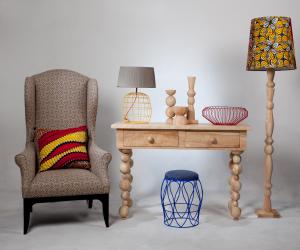Common Methods was born out of Agata Karolina's own experience of the creative exchange that happens between peers while studying at the Design Academy Eindhoven. She wanted to replicate the collaborative aspects of that experience in South Africa.
More than bring designers together, Karolina wanted to match skillsets: "So it wasn't about bringing designers from anywhere in the world, who did anything together. I wanted them to match each other's spaces, mindsets and also materials that they work in."
She paired two sets of designers for the project. Dutch textile designer Lio de Bruin and South African Matthew Nielson of leather accessories label Matblac worked together exploring new products made of leather. (Watch last week's interview with them here.) Another group – South African Natalie Du Toit of Indigi Design, British Phil Procter, who is based in The Netherlands, and Charles Haupt of Bronze Age, was the manufacturing partner – collaborated on designs made of bronze.
Like Nielson and De Bruin, Du Toit and Procter are quite different in their aesthetic approach: she creates pattern-driven textiles and furniture while his furniture and products are pared down and minimalist.
This creative tension, in tandem with the dynamic process of manufacturing, had some innovative results. "Because Phil and Natalie work in very different ways and we [Bronze Age] did the manufacturing, the end product is very different to what they normally do," explains Haupt. "It was really interesting to create something that is very sculptural and handmade as opposed to more fabricated works."
Together the trio ended up using materials and process in a new way. They developed a process of applying patterns to flat metal surfaces that were then reshaped and bent into three-dimensional objects. Bending the flat pieces into shapes also stretched the surface pattern in beautiful ways, creating a responsive texture and accentuating the shape of the object.
"The patterns were created using found objects lying around. It was very unplanned," says Du Toit. "It was our intention to use what was at hand, to use something that people would not ordinarily pay attention to and make something beautiful out of that."
They employed the alternating pattern of a metal file and the tread from a bolt to create intricate surface designs for a range of bronze vases, lampshades and a bowl.
What I find really interesting about the resulting objects is that they look very high-tech, as if they where milled or printed with this pattern stretching over the surface, says Procter.
"But through what was really a collaborative development, we figurde out a very simple way to apply the pattern, achieving something that looks complex but is made in quite a low-tech manner."
All agree that the intense six-week process has influenced their individual approaches. "It was a huge learning curve to work so closely with a processs that I knew absolutely nothing about," explains Procter. He found the prospect of creating any form using the metal casting process quite daunting as he is used to working within the material constraints of wood and sheet metal. "With bronze casting it is limitless in terms of form and that was quite inspirational to work with."
Karolina concludes that the results form the collaborative experiment exceeded her expectations. Witnessing the designers pushing their boundaries and moving out of their personal comfort zones to produce something together was incredibly rewarding, she says.








